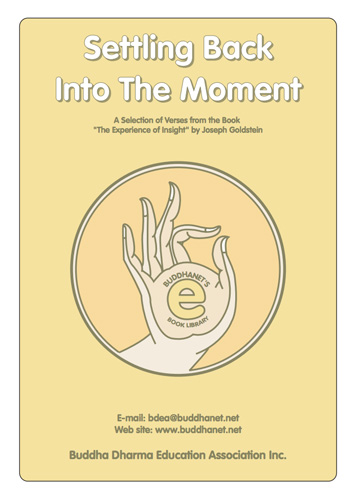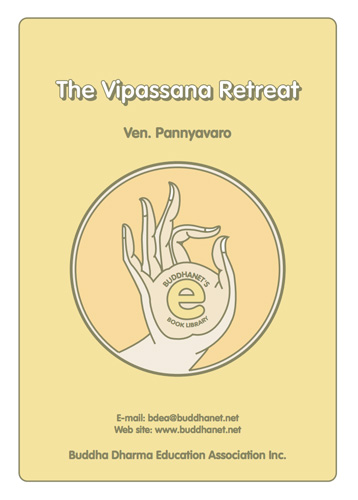 Most viewed - eBook Library Most viewed - eBook Library |

Recollections.pdfThe Ten Recollections - A Study Guide4116 viewsThe ten recollections are a set of meditation themes that highlight the positive role that memory and thought play in training the mind. They employ memory to sensitize the mind to the need for training, to induce feelings of confidence and well-being conducive for concentration, to keep the topics of concentration in mind, to produce tranquility and insight, and to incline the mind toward the deathless when tranquility and insight have grown sufficiently strong.
|
|

scrn_metta.pdfMetta Bhavana; Loving-kindness; Meditation4113 viewsVen. Dhammarakkhita
This is short explanation on how to practise Metta Bhavana or Loving-kindness Meditation given as a three-day weekend retreat at Dhammodaya Meditation Centre in Nakhon Pathom in Thailand, by an Australian monk, Ven. Dhammarakkhita (Jeff Oliver).
|
|

settleback.pdfSettling Back Into The Moment4108 viewsA selection of verses from the book 'Experience of Insight' , by Joseph Goldstein. This book belongs to a different genre, not a book in the sense of having a beginning and an end. It is a compilation of excerpts that stand alone in meaning whichever way your finger may flip open the page. Readers are strongly encouraged to read Joseph Goldstein's Experience of Insight - a simple and direct guide to Buddhist Meditation (Published by Shambala Publications, Inc.) from whose book this compilation is attributed.
|
|

seeding.pdfSeeding the Heart4056 viewsTo learn about the radiating of loving-kindness to all beings with children, we have to tap into the store of knowledge accumulated by lay people and parents. It must be knowledge which has grown out of years of living and loving with children and young adults. Gregory Kramer, father of three boys, shows us here with subtle but precise adjustments in the standard practice of loving-kindness meditation he was able to anchor it in the lives of his children.
|
|

essentialsof.pdfEssentials of Buddhism4055 viewsIt is based on the Theravada Buddhism syllabus of the Postgraduate Diploma Examination in Buddhist Studies course of the Buddhist and Pali University of Sri Lanka. Since the work is meant for students, every chapter appears as a unit by itself and is confined to a few pages. Ven. Ganarama is the Principal of the Buddhist and Pali College of Singapore.
|
|

v_retreat6.pdfThe Vipassana Retreat4048 viewsVen. Pannyavaro
Vipassana meditation requires long-term commitment. While it can be done to some extent in everyday life, realistically for the practice to deepen it needs to be done intensively in a supportive retreat situation. Vipassana meditation is developmental, so to realise its ultimate benefit it has to be sustained with appropriate intensity under supportive conditions. Ven. Pannyavaro, a practitioner of over 30 years, guides you through the vipassana experience in a retreat situation, in a systematic and practical way.
|
|

geth0401.pdfCan Killing a Living Being Ever Be an Act of Compassion?3997 viewsThe analysis of the act of killing in the Abhidhamma & Pali Commentaries.
Abstract: In the Theravadin exegetical tradition, the notion that intentionally killing a living being is wrong involves a claim that when certain mental states (such as compassion) are present in the mind, it is simply impossible that one could act in certain ways (such as to intentionally kill). Contrary to what Keown has claimed, the only criterion for judging whether an act is “moral†(kusala) or “immoral†(akusala) in Indian systematic Buddhist thought is the quality of the intention that motivates it. The idea that killing a living being might be a solution to the problem of suffering runs counter to the Buddhist emphasis on dukkha as a reality that must be understood. The cultivation of friendliness in the face of suffering is seen as something that can bring beneficial effects for self and others in a situation where it might seem that compassion should lead one to kill.
|
|

paliwordday.pdfA Pali Word A Day3959 viewsA selection of Pali words for daily reflection. This booklet aims to assist new Buddhist students who are unfamiliar with some of the Pali words often used in the study of Buddhism. As the title suggests, it encourages the learning and use of Pali words by learning one word a day. This booklet can serve both as a dictionary and a glossary of terms for your reference.
|
|

mindread.pdfReading the Mind3941 viewsKhun Kee Nanayonestablished a Dhamma centre, Khao-Suan-Luang in 1945. Upasika Kee attracted Dhamma students, and residents came to include both female lay devotees and white-robed nuns. These Dhamma talks were mainly given to the women who stayed at her centre to practice meditation. After listening with calm and centred mind, they would all sit in meditation together.
|
|

Mindfulness_Breathing.pdfMindfulness of Breathing3940 viewsThis is a useful anthology of important and pragmatic source material from the Pali Canon and Commentaries on the technique of Anapana, or breath-awareness meditation. It includes the Discourse on Respiration-Mindfulness from the Majjhima Nikaya, commentary from the Vishuddhimagga (Path of Purification), and analyses of other passages and Suttas.
|
|
| 347 files on 35 page(s) |
 |
 |
 |
11 |  |
 |
 |
|
